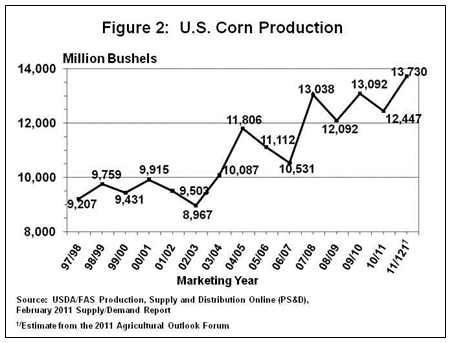Vol. 27, Issue 6, March 7, 2011 – PDF version
Jose G. Peña, Texas AgriLife Extension Economist-Management
Prices for grain and cotton continue to show strength after a slight weakness last week. The weakness was probably associated with the political unrest in the Middle East, especially in Libya, which is causing crude oil prices to move sharply higher and investors to grow nervous. Very tight U.S. and world supplies and strong U.S. and export demand is fueling the market. The market is providing excellent pricing opportunities for 2011 crops (See Figure 1).
Near-by (March ’11) futures prices for corn and cotton, jumped to near record highs, weakened slightly last week, but were back up to close at $7.29/bu. and $2.08/lb., respectively, on Thursday (03/03/2011).
December ’11 corn and especially cotton futures prices have been showing significant volatility, but closed at $6.16/bu. and $1.27/lb respectively, on Thursday (03/03/2011)
The surge in corn began as USDA’s October 8, 2010 supply/demand report lowered the U.S. corn production estimate by almost one-half billion bushels—USDA was still expecting a record level of corn production as late as September. By January USDA dropped the 2010/11 season’s corn production estimate to 12.447 billion bushels, down over 900 million bushels from early season estimates. The reduced estimate is primarily as a result of below-trend average yield of 152.8 bushels, 11.9 bushels below the record average yield of 2009. Meanwhile, the estimate of consumption has remained high, creating very tight supplies. The estimate of corn use for ethanol production will account for almost 40 percent of USDA’s February 2011 corn production estimate. Surging crude oil prices may increase demand for corn use for ethanol production as gasoline prices are at near record highs. Total corn use has remained at about 13.5 billion bushels, dropping the estimate of ending stocks to about 675 million bushels, the lowest in about 18 years.
The market outlook for most commodities for 2011 remains bright.
Net Farm Income Up
Meanwhile, gradual U.S. economic growth, strong export demand and record or near record high commodity prices indicates that the farm economy remains strong. USDA’s February 14, 2011 estimate of net U.S. farm income at a record $94.7 billion is up 19.9 percent from $79.0 billion in 2010 and up over 50% from 2009’s financially difficult year with $62.2 billion. If realized, net farm income in 2011 will be $8.1 billion (9.4%) above the previous record of $86.6 billion in 2008.
Grains/Corn
According to the 2011 Grains and Oilseeds Outlook Forum report, released on February 25, 2011, the 2011/12 outlook for the major grains and oilseeds in the U.S. reflects a tight overall supply situation for corn and soybeans domestically and strong demand for U.S. milling wheat in world markets. High prices and extraordinarily favorable net returns are expected to expand 2011 planted area with combined corn and soybean plantings again expected to set a record.
The Outlook Forum estimated that 92.0 million acres of corn would be planted this season, up 4.3 percent from 88.2 million acres planted last year. Based on the historical planted-to-harvested ratio and a yield estimate of 161.7 bu./acre the Forum forecasted that a record crop of 13.73 billion bushels will be produced this season (See Figure 2). With total use estimated at 13.56 billion bushels, ending stocks are expected to increase by about 200 million bushels to 876 million, still a tight level of carryover.
USDA’s initial producers planting intentions report on March 31, 2011, based on a survey of producers, is an important report to watch for.
Cotton
According to the 2011 Agricultural Outlook Forum’s U.S. and World Cotton Outlook report, released on February 25, 2011, the 2010/11 U.S. and world cotton situation reflects extremely tight supplies relative to demand, resulting in prices which have surpassed historical records. According to the report, world cotton production declined an estimated 17 percent between 2006/07 and 2009/10, primarily because increases in cotton prices lagged those of grains and oilseeds. USDA’s first 2011/12 cotton projections include an 11 percent increase in world production to a record 127.5 million bales, combined with a more modest increase in world consumption.
USDA projects that U.S. acreage planted to cotton in 2011 will increase nearly 19 percent over last year to 13.0 million acres, the highest area since 2006. Using the historical planted-to-harvested acreage ratio and a forecast yield of 810 lbs/acre, USDA estimates that 19.5 million bales will be produced this season, up 1.2 million bales from 18.3 million bales produced during the 2010/11 season (See Figure 3).
USDA’s projected the 2011/12 marketing year average price received by producers at $1.10/lb, up 28.5 cents from this past season’s average price of $0.815/lb.
Appreciation is expressed to Dr. J. Mark Welch, Extension Economist-Grain Marketing for his contribution to and review of this article.



